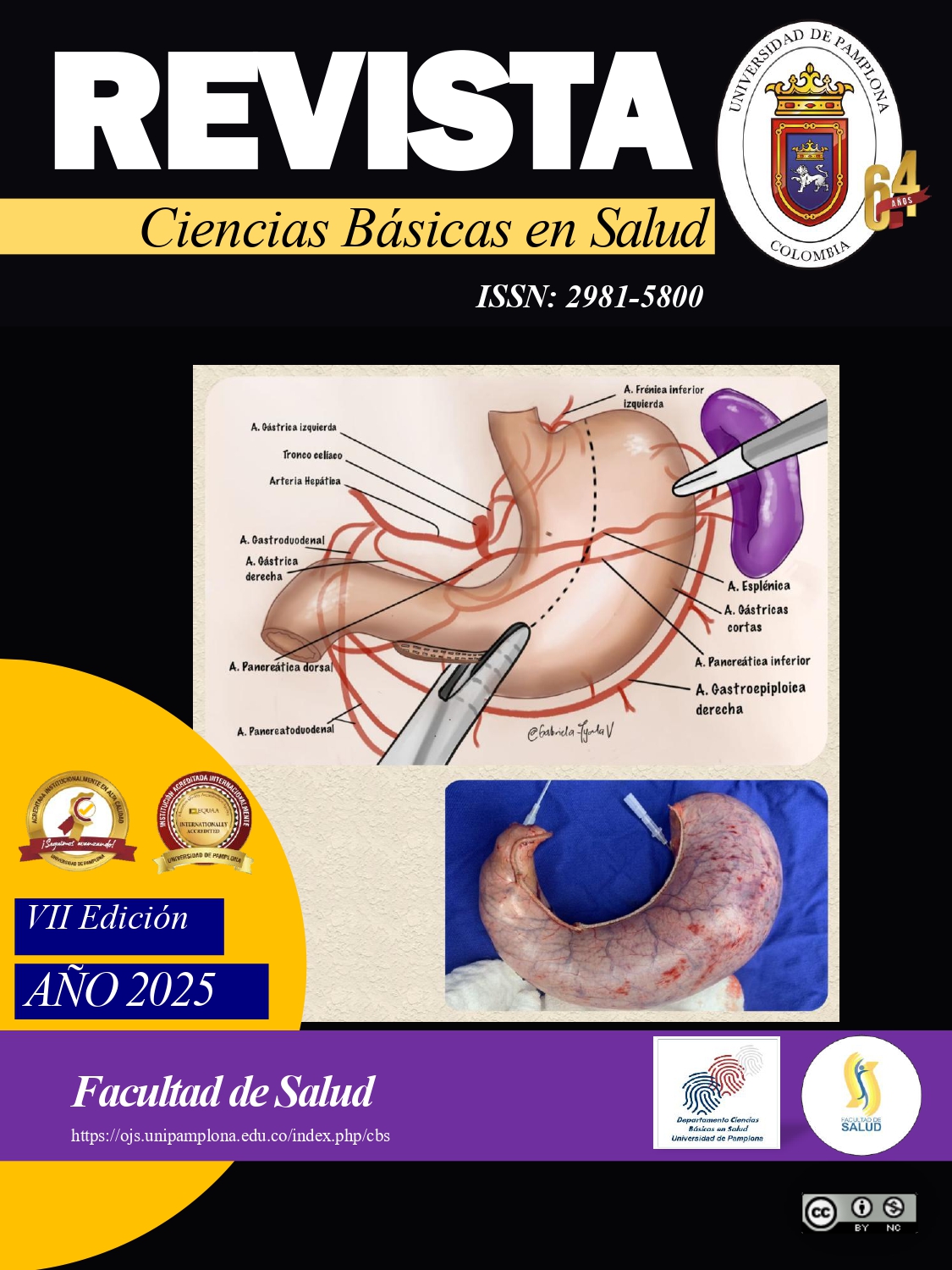Redes de diagnósticos de enfermedades asociadas a la COVID-19 de 2020 a 2022 en el centro de México
DOI:
https://doi.org/10.24054/cbs.v3i1.3638Palabras clave:
Análisis de Redes Neuronales, Aprendizaje Organizacional, COVID-19, Diagnósticos, EnfermedadesResumen
Introducción: Los diagnósticos de las enfermedades asociadas a la COVID-19 cobran relevancia a la luz de su incidencia y prevalencia en el centro de México. Objetivo: El objetivo del presente trabajo fue comparar un modelo de red neuronal con los hallazgos reportados en la literatura. Metodología: Se realizó un trabajo documental, transversal, correlacional y retrospectivo con una muestra de 6500 casos seleccionados por entidad centralizada en México. Resultados: Los resultados demuestran la secuencia de aprendizaje que va de los diagnósticos hacia las entidades de aplicación lo cual revela una red colaborativa orientada por las tomografías. Discusión: Con relación al estado del arte donde prevalecen hallazgos centrados en las decisiones, estrategias colaborativas y gestoras de conocimiento, el presente trabajo sugiere incluir estas dimensiones a fin de poder anticipar las respuestas de las instituciones de salud pública en futuras contingencias sanitarias.
Descargas
Referencias
Argyris, C., & Schön, D. A. (1978). Organizational learning: A theory of action perspective. Addison-Wesley.
Barney, J. B. (1991). Firm resources and sustained competitive advantage. Journal of Management, 17(1), 99-120. https://doi.org/10.1177/014920639101700108
Chowdhury, M. E. K., Rahman, M. A., Islam, M. R., Chisty, M. A., & Azad, A. K. (2021). Maternal mortality during the COVID-19 pandemic in Bangladesh: A nationwide cross-sectional study. PLOS Medicine, 18(8), e1003783. https://doi.org/10.1371/journal.pmed.1003783
Cohen, W. M., & Levinthal, D. A. (1990). Absorptive capacity: A new perspective on learning and innovation. Administrative Science Quarterly, 35(1), 128-152. https://doi.org/10.2307/2393553
Crossan, M. M., Lane, H. W., & White, R. E. (1999). An organizational learning framework: From intuition to institution. Academy of Management Review, 24(3), 522-537. https://doi.org/10.5465/amr.1999.2202135
DiMaggio, P. J., & Powell, W. W. (1983). The iron cage revisited: Institutional isomorphism and collective rationality in organizational fields. American Sociological Review, 48(2), 147-160. https://doi.org/10.2307/2095101
Dodgson, M. (1993). Organizational learning: A review of some literatures. Organization Studies, 14(3), 375-394. https://doi.org/10.1177/017084069301400303
Easterby-Smith, M., Crossan, M., & Nicolini, D. (2000). Organizational learning: Debates past, present and future. Journal of Management Studies, 37(6), 783-796. https://doi.org/10.1111/1467-6486.00203
Fiol, C. M., & Lyles, M. A. (1985). Organizational learning. Academy of Management Review, 10(4), 803-813. https://doi.org/10.5465/amr.1985.4279103
Freeman, R. E., & Reed, D. L. (1983). Stockholders and stakeholders: A new perspective on corporate governance. California Management Review, 25(3), 88-106.
Garvin, D. A. (1993). Building a learning organization. Harvard Business Review, 71(4), 78-91. Recuperado de https://hbr.org/1993/07/building-a-learning-organization
Grasselli, G., Zangrillo, A., Zanella, A., Antonelli, M., Cabrini, L., Castelli, A., ... & Pesenti, A. (2020). Baseline characteristics and outcomes of 1591 patients infected with SARS-CoV-2 admitted to ICUs of the Lombardy region, Italy.
JAMA, 323(16), 1574-1581. https://doi.org/10.1001/jama.2020.5394
Guan, W., Ni, Z., Hu, Y., Liang, W., Ou, C., He, J., ... & Zhong, N. (2020). Clinical characteristics of coronavirus disease 2019 in China. The New England Journal of Medicine, 382(18), 1708-1720. https://doi.org/10.1056/NEJMoa2002032
Huber, G. P. (1991). Organizational learning: The contributing processes and the literatures. Organization Science, 2(1), 88-115. https://doi.org/10.1287/orsc.2.1.88
Kotlar, B., Gerson, E. M., Petrillo, S., Langer, A., & Tiemeier, H. (2021). The impact of the COVID-19 pandemic on maternal and perinatal health: A scoping review. Reproductive Health, 18, Article 10. https://doi.org/10.1186/s12978-021-01070-6
Lawrence, P. R., & Lorsch, J. W. (1967). Differentiation and integration in complex organizations. Administrative Science Quarterly, 12(1), 1-47. https://doi.org/10.2307/2391211
March, J. G., & Simon, H. A. (1958). Organizations. Wiley. (No DOI disponible; consulta el libro clásico en bibliotecas académicas).
Meyer, J. W., & Rowan, B. (1977). Institutionalized organizations: Formal structure as myth and ceremony. American Journal of Sociology, 83(2), 340-363. https://doi.org/10.1086/226550
Mintzberg, H. (1979). The structuring of organizations: A synthesis of the research. Prentice-Hall.
Nonaka, I. (1994). A dynamic theory of organizational knowledge creation. Organization Science, 5(1), 14-37. https://doi.org/10.1287/orsc.5.1.14
Nonaka, I., & Takeuchi, H. (1995). The knowledge-creating company: How Japanese companies create the dynamics of innovation. Oxford University Press
Pfeffer, J., & Salancik, G. R. (1978). The external control of organizations: A resource dependence perspective. Harper & Row.
Richardson, S., Hirsch, J. S., Narasimhan, M., Crawford, J. M., McGinn, T., Davidson, K. W., ... & Northwell COVID-19 Research Consortium. (2020). Presenting characteristics, comorbidities, and outcomes among 5700 patients hospitalized with COVID-19 in the New York City area. JAMA, 323(20), 2052-2059. https://doi.org/10.1001/jama.2020.6775
Schein, E. H. (1985). Organizational culture and leadership. Jossey-Bass.
Senge, P. M. (1990). The fifth discipline: The art and practice of the learning organization. Doubleday/Currency.
Descargas
Publicado
Número
Sección
Licencia
Derechos de autor 2025 Revista Ciencias Básicas en Salud

Esta obra está bajo una licencia internacional Creative Commons Atribución-NoComercial 4.0.







